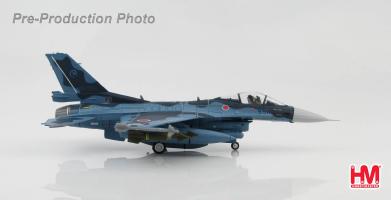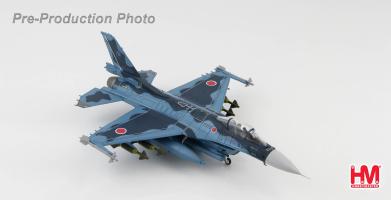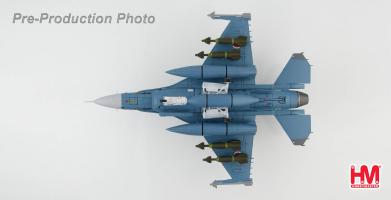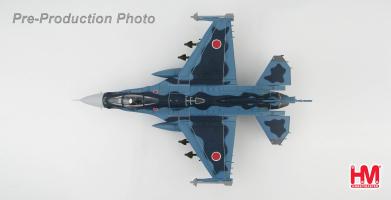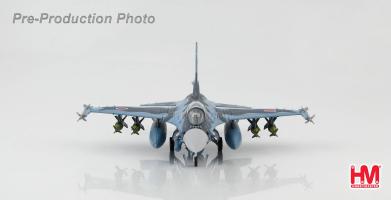Hobby Master Archive
Air Power Jets 1/72
F-2
Japan F-2A 93-8551, ADTW, JASDF
Hobby Master 1/72 Air Power Series HA2711 Japan F-2A 93-8551, ADTW, JASDF
Die-cast metal. Superb detailing in 1/72 scale. Pre-painted with pad applied markings. Fully assembled. Weapons that are not permanently attached. Includes 4 AAM-4 missiles Comes with crew figures Display stand included. Option to display model with wheels up or down. Minimum use of plastic.
Specifications Mitsubishi F-2A Nickname - Viper Zero Designation - Single-seat Multi-role fighter Crew - 1 (or 2 for the F-2B) Performance Powerplant: (1) General Electric F110-GE-129 turbofan Dry thrust - 76 kN (17,000 lbf) Thrust with afterburner - 131 kN (29,500 lbf) Maximum speed - Mach 2.0 Range - 520 miles (834 km) on anti-ship mission Service ceiling - 59,000 ft (18,000 m) Dimensions Length - 50 ft 11 in (15.52 m) Wingspan - 36 ft 6 in (11.13 m) Height - 15 ft 5 in (4.69 m) Wing area - 375 ft² (34.84 m²) Weights Empty - 21,000 lb (9,527 kg) Loaded - 33,000 lb (15,000 kg) Max takeoff - 48,700 lb (22,100 kg) Armament (1) 20 mm JM61A1 cannon Capable of carrying up to 17,820 lb (8,085 kg) weapon load on 11 hard points. They are located - #1 and #11 at the wing tips, #2-5 and #7-10 under the wings, and #6 under the fuselage. Possible Weapons Air-to-air - AIM-9 Sidewinder, AIM-7 Sparrow, Mitsubishi AAM-3, Mitsubishi AAM-4 Air-to-ground - ASM-1 and ASM-2 anti-ship missiles. Various free-fall bombs with GCS-1 IIR seeker heads, Mk 82 and JM177 bombs, CBU-87, JDAM and JLAU-3/A or RL-4 rocket pods. Others - J/AAQ-2 FLIR Avionics Mitsubishi Active Electronically Scanned Array radar system including J/APG-1. Some differences between the F-2A and the F-16 F-2A has a 25% larger wing area. F-2A is manufactured using composite materials to reduce overall weight and radar signature. F-2A is longer and wider nose to accommodate phased-array radar. F-2A has a larger tail-plane. F-2A has a larger air intake. F-2A has a three-piece cockpit canopy.
F-2A is equipped with a drogue parachute.
During the 1980s General Dynamics, the developer of the F-16, proposed another version of the F-16 called the F-16 Agile Falcon. The US military opted not to get involved because they were busy upgrading their present fleet as well as developing the new F-22/JSF. Japan had decided to purchase the F-16 to replace its aging F-1 aircraft but then decided to develop the F-16 Agile Falcon concept. The new aircraft for the JASDF (Japan Air Self Defense Force) would be the F-2 and manufactured with a 60/40 split between Mitsubishi Heavy Industries and Lockheed Martin. Lockheed Martin bought General Dynamics in 1993. Production started in 1996 with the first aircraft being delivered in 2000. 94 of the F-2 aircraft are scheduled to be manufactured. It might look like an F-16 but the Mitsubishi F-2 is a completely new fighter. The general shape may say F-16 and a few things that the F-2 and the F-16 have common are the engine, landing gear, air intake door and the 20 mm gun. But the F-2 has a longer and wider nose to accommodate phased-array radar with 25% larger wing. It is made from a composite material to reduce weight and radar signature, a larger tail plane and larger air intake. The pilot canopy is a stronger three-piece construction. The F-2 is equipped with a drogue chute just like the NATO version of the F-16. The single seat fighter is the F-2A while the two seat version is a trainer that is fully Combat capable.
JASDF Mitsubishi F-2A serial 93-8551 c/n 1051 was first assigned to the Koku Kaihatsu Jikken Shudan (Air Development and Test Command) headquartered in Iruma with the operations branch located at the Hiko Kaihatsu Jikkendan (Air Development and Test Wing) at Gifu AB. The ADTW tests new systems and aircraft to make certain everything was up to the high standards of the JASDF. Next 93-8551 was assigned to the 3 Kokudan, 3 Hikotai, Misawa AB as the Boss Bird and later re-assigned to the 8 Kokudan, 6 Hikotai, Tsuiki AB.
| Added to archive | 2015-11-19 |
| Last modified | 2015-11-19 |
| Leaflet | 2014-04-01 April 2014 |
